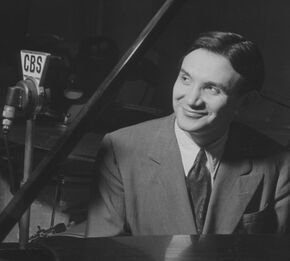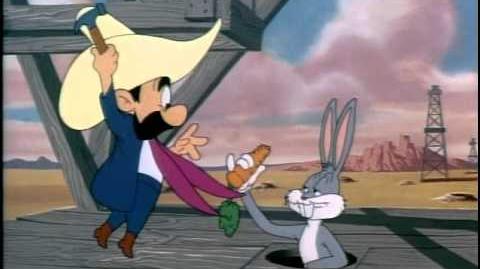
Raymond Scott at the keyboard on CBS Radio ca. 1937
Powerhouse is a 1937 instrumental song by jazz bandleader Raymond Scott. It is perhaps best known today as the iconic "assembly line" music in animated cartoons released by Warner Brothers in the 1940s, 1950s, and early 1960s.
History[]
Scott's Quintette (actually a sextet) first recorded "Powerhouse" in New York on February 20, 1937, along with three other titles. This recording was first commercially issued on the Irving Mills-owned Master Records label as Master 111 (mx. M-120-1), coupled with another Scott composition, "The Toy Trumpet."
After the demise of the Master label late in 1937, "Powerhouse" was reissued on Brunswick 7993, and subsequently on Columbia 36311 (after the CBS purchase of ARC, which included the Brunswick catalog). The same take was issued on all releases. (An unreleased 1939 recording by the original Scott Quintette was issued in 2002 on the two-CD Scott compilation Microphone Music, on the Basta label.)
Both "Powerhouse" and "The Toy Trumpet" remained in Scott's repertoire for decades, both were adapted for Warner cartoon soundtracks by music director Carl Stalling along with a dozen other Scott titles, and both have been recorded by numerous other artists. Stalling, who spiced his scores with "Powerhouse" dozens of times, never created a complete version of the work; all his adaptations exist as excerpts.
The United States publisher of the title is Music Sales Corporation. Outside the U.S., the title is controlled by Warner/Chappell Music.
Acquisition by Warner Bros[]
In 1943, Scott's music publishing company, Circle Music, was sold to Warner Brothers. Because Scott's titles were now controlled by Warner, Stalling was given access to the composer's catalog to adapt his popular melodies in Warner cartoon scores. Research has not yet determined whether the acquisition of Scott's catalog and subsequent adaptions by Stalling were intentional or serendipitous. Many of Scott's late 1930s compositions had an animated, frenetic quality, and his titles were humorous and absurd (e.g., "Boy Scout in Switzerland," "War Dance for Wooden Indians," "Reckless Night on Board an Ocean Liner," and "Dinner Music for a Pack of Hungry Cannibals," all of which were quoted by Stalling in various cartoons). [1]
There is a prevalent misconception that Scott composed music for Warner cartoons. However, the Scott titles adapted by Carl Stalling were originally composed between 1936 and 1942 for Scott's small jazz ensemble (his "Quintette") or his expanded big band. Scott had no involvement with Stalling's usages, he never worked for Warner Bros., and except for a one-minute TV commercial for County Fair Bread in the 1960s, he never composed music for animation.
The first use of "Powerhouse" in a Looney Tunes cartoon occurred in the 1943 short "Porky Pig's Feat", directed by Frank Tashlin. Also in 1943, it was used in the Private Snafu shorts "Gripes", "Spies", and "Rumors"; "Gripes" was released two weeks before "Porky Pig's Feat". It was subsequently featured in over forty other Warner cartoons. The 1953 Merrie Melodies cartoon "Duck Dodgers in the 24½th Century", directed by Chuck Jones, contains Stalling's lengthiest adaptation of the "Powerhouse A" section, clocking in at one minute and twenty-five seconds. Milt Franklyn also occasionally used the soundtrack, but it was never used in any of the cartoons scored by William Lava. "Powerhouse" made its final usage in the Golden Age in Freleng's "The Jet Cage" in 1962, where the "Powerhouse A" section was used as title card music.
An entire 1993 episode of Animaniacs, "Toy Shop Terror", was set to Warner Bros. music director Richard Stone's arrangement of the composition. It is also a systematic rock theme in the 2003 feature film Looney Tunes Back in Action.
The "Powerhouse B" section was repurposed for the song, "Hard Hat Time", in Bugs Bunny Builders arranged with new lyrics by composer Matthew Janszen.
Composition Structure[]
Structurally, "Powerhouse" consists of two distinct—and seemingly unrelated—musical themes, played at different tempos. After an extended introduction and vamp introducing each member of the quintet in turn (in pyramid fashion enlarging the texture), the first theme, sometimes referred to as "Powerhouse A", commences in a frantic four-bar 16th-note passage, outlining a tonic sixth harmony in the key of E-flat (C – E♭– G♭– B♭), with chromatic lower-neighbor decoration, typically employed in chase and high-speed vehicle scenes to imply whirlwind velocity. This running motif is modally ambiguous in terms of major or minor, and this is emphasized in the accompanying bass line. After an eight-bar bridge in falling 16ths heard originally from the tenor sax, the theme repeats, concluding with a two-bar variant of this motif in syncopated staccato eighths. A twenty-bar interlude provides mild relief from the hubbub, the last eight bars of which are notable for their impressionistic chromaticism. The frenetic 16ths return for a quick 16-bar chorus. A brief moment of silence then occurs, commonly referred to as a caesura.
The slower theme, at not quite half the tempo of “A”, referred to as "Powerhouse B," is the "assembly line" music, which sometimes accompanies scenes of repetitive, machine-like activity. It begins (after the drums start the tattoo in the new tempo) with a 2-bar ostinato bass setting up the seeming relative minor (C – E – E♭– G♭ – F – D – E♭ – E). The clarinet and sax then present the iconic “B” motif, which alternates the use of E-natural and E-flat in a repeating pattern, to reassert the modal ambiguity (is the powerhouse AC or DC?). This is followed up by a truncated (14-bar) double chorus in F for the solo tenor sax. Once again, a brief full stop.
A repeat of the A section, with a slightly shortened vamp, ensues, with a seven-bar coda (in place of the interlude) to wrap things up. "Powerhouse" in its entirety places "B" in the center while "A" opens and closes the work, in the sequence A-B-A (Ternary form).
Usage[]
Powerhouse A[]
- "Gripes" - Snafu tries to hide from a falling bomb.
- "Porky Pig's Feat" - The hotel manager tries to bust open Daffy's and Porky's door.
- "Falling Hare" - Bugs chases the Gremlin with a wrench.
- "An Itch in Time" - A. Flea runs away from Willoughby's mouth.
- "Puss n' Booty" - Rudolf waits for the new canary.
- "Little Red Riding Rabbit" - Bugs makes his final resolve to replace the Big Bad Wolf with Red Riding Hood under the weights.
- "Rumors" - The rumors attack Snafu.
- "I Got Plenty of Mutton" - Ram charges at a log the wolf is in.
- "A Lecture on Camouflage" - Snafu uses a tractor to clean up the tracks of his car tires.
- "Birdy and the Beast" - Schnooks searches for Tweety in Butch's food bowl.
- "The Old Grey Hare" - "Come past the years 1950..."
- "Going Home" - Snafu sky-writes words with a plane.
- "The Great Piggy Bank Robbery" - "Stolen piggy bank? Sorry, can't take little cases like that."
- "The Mouse-Merized Cat" - The opening.
- "The Up-Standing Sitter" - Daffy nearly runs into Spike.
- "His Bitter Half" - Daffy does chores around his wife's house.
- "It's Hummer Time" - "The Works" machine is activated.
- "The Fair Haired Hare" - Construction workers build a house atop of Bugs' hole.
- "The Hasty Hare" - The opening; "Uh, ain't you got something more sporty?"
- "Duck Dodgers in the 24½th Century" - Duck Dodgers travel to Planet X.
- "I Gopher You" - Pan view of the factory inside.
- "The Hole Idea" - "There is none other than that unsung genius, Professor Calvin. Q. Calculus."
- "Jumpin' Jupiter" - The Boring Mechanism.
- "Rocket Squad" - Daffy and Porky walking quickly at the Interplanet Police Force.
- "Gee Whiz-z-z-z-z-z-z" - Wile E. rides a jet motor.
- "There They Go-Go-Go!" - Spiked balls flies onto Wile E.
- "The Jet Cage" - Title card.
Powerhouse B[]
- "Spies" - Private Snafu's brain lock deteriorates from alcohol.
- "Hiss and Make Up" - Mustard stamps paw-prints around the house.
- "Swooner Crooner" - Any time the egg production line is shown.
- "The Chow Hound" - Camel slowly tries to carry Private Snafu's lunch.
- "Trap Happy Porky" - The Rube Goldberg contraption.
- "Baby Bottleneck" - Porky and Daffy on the conveyor belt.
- "The Great Piggy Bank Robbery" - Daffy finding footprints on a wall and ceiling.
- "House Hunting Mice" - Any time the automatic sweeper cleans up a mess.
- "It's Hummer Time" - "The Fence" punishment; "No, not happy birthday!"; "The rain pipe?"; "The Thinker" punishment; "No, not the works!"
- "Early to Bet" - The dog pulls out the Supreme Cat; "The Gesundheit" punishment; the "Roll Out the Barrel" punishment.
- "Oily Hare" - Tycoons build an oil rig.
- "Cat-Tails for Two" - Speedy bends the dynamite pipe with a wrench.
- "I Gopher You" - The bottle capper.
- "Wild Wife" - The parking meter is replaced with a fire hydrant.
- "Yankee Dood It" - "...increase production, and show a profit."
- "The Mouse on 57th Street" - Jackhammers.
- "Compressed Hare" - A chain reaction that ends with Wile E. being smashed by his bed.
- "A Sheep in the Deep" - Ralph wakes up.
Gallery[]
References[]

